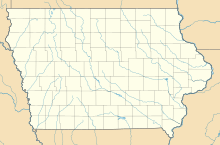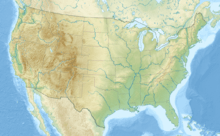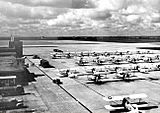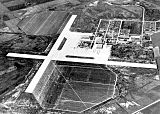Ottumwa Regional Airport facts for kids
Quick facts for kids
Ottumwa Regional Airport
|
|||||||||||||||
|---|---|---|---|---|---|---|---|---|---|---|---|---|---|---|---|
 |
|||||||||||||||
| Summary | |||||||||||||||
| Airport type | Public | ||||||||||||||
| Owner | City of Ottumwa | ||||||||||||||
| Serves | Ottumwa, Iowa | ||||||||||||||
| Elevation AMSL | 845 ft / 258 m | ||||||||||||||
| Coordinates | 41°06′24″N 092°26′53″W / 41.10667°N 92.44806°W | ||||||||||||||
| Map | |||||||||||||||
| Runway | |||||||||||||||
|
|||||||||||||||
| Statistics | |||||||||||||||
|
|||||||||||||||
|
Source: Federal Aviation Administration
|
|||||||||||||||
Ottumwa Regional Airport (IATA: OTM, ICAO: KOTM, FAA LID: OTM) is an airport in Iowa, USA. It is located about six miles northwest of Ottumwa. The airport used to be called Ottumwa Industrial Airport.
The City of Ottumwa owns this airport. It is managed by a group called the Airport Advisory Board. This airport is mainly used for general aviation, which means it's for private planes and small charter flights, not big airlines.
Contents
Airport History
The airport started as a Navy training base during World War II. This was a time when the United States needed many pilots. The Navy chose a large area of land near Ottumwa in 1942. They started building the base on August 6, 1942.
The first group of young Navy pilots, called Naval Aviation Cadets, arrived on March 10, 1943. They began their flight training just four days later. The base was very busy, with planes flying for thousands of hours each day.
Planes used for training included the SNJ, the N3N Canary, and the N2S Kaydet. Many buildings were built for the Navy, like hangars, barracks, and classrooms. The streets on the base were named after famous U.S. Navy aircraft carriers and important Navy and Marine Corps leaders.
Unlike many other temporary bases, NAS Ottumwa was built with strong brick. This was because good wood was hard to find during the war. Because of this, about fourteen of the original brick buildings are still standing today. The Navy also set up 19 smaller landing strips nearby.
Many important people served at NAS Ottumwa. One was Richard Nixon, who later became a U.S. President. Another was Scott Carpenter, one of the first American astronauts to orbit Earth. Jesse L. Brown, the first African-American Navy pilot, also trained here. In total, over 4,600 Navy pilots earned their "wings of gold" at this base.
After World War II ended, the base changed. It stopped flight training and focused on classroom lessons. In 1947, the Navy moved its training school to another base. The City of Ottumwa then took over the airport.
Today, people are working to save the airport's Navy history. The old Administration Building is being restored. It will become a museum about naval aviation. This building is now listed on the National Register of Historic Places.
Civilian Airport Use
After the Navy left, the airport started serving civilian flights. In 1947, Mid-Continent Airlines began flying to Ottumwa. Other airlines, like Braniff and Ozark, also offered flights over the years. The last airline service ended in 2001. Since then, Ottumwa has not had regular airline flights.
In 2002, the City of Ottumwa and the Federal Aviation Administration built a new airport terminal. This new building cost almost $1 million. In 2008, the airport's name was changed from Ottumwa Industrial Airport to Ottumwa Regional Airport.
The airport also received a big upgrade in 2009. They spent $3.9 million to repave and make one of the runways longer. They also added a new taxiway and improved the lighting.
Other Uses of the Airport
The airport area is used for more than just planes. It has become a place for education and businesses. The Ottumwa Industrial Park, located next to the airport, has attracted factories and offices.
A Job Corps training center opened nearby in 2012. The biggest educational presence is Indian Hills Community College. Their "North Campus" offers many programs. These include training for aircraft maintenance, pilot training, and avionics technology. They also teach skills like car repair, truck driving, and welding.
Airport Facilities
The airport covers about 1,600 acres (647 hectares) of land. It is located 845 feet (258 meters) above sea level.
It has two main runways:
- Runway 13/31 is 5,885 feet (1,794 meters) long and 150 feet (46 meters) wide. It has an asphalt and concrete surface. This is the main runway.
- Runway 4/22 is 4,600 feet (1,402 meters) long and 100 feet (30 meters) wide. It has an asphalt surface.
In 2015, the airport had about 16,450 aircraft operations. This means planes took off or landed about 45 times each day. In 2017, 25 aircraft were based at the airport. These included single-engine planes, multi-engine planes, and jet planes.
- FAA Airport Diagram (PDF), effective 15 December 2011
- FAA Terminal Procedures for OTM, effective 15 December 2011
- Resources for this airport:
- FAA airport information for OTM
- AirNav airport information for KOTM
- ASN accident history for OTM
- FlightAware airport information and live flight tracker
- NOAA/NWS latest weather observations
- SkyVector aeronautical chart, Terminal Procedures






